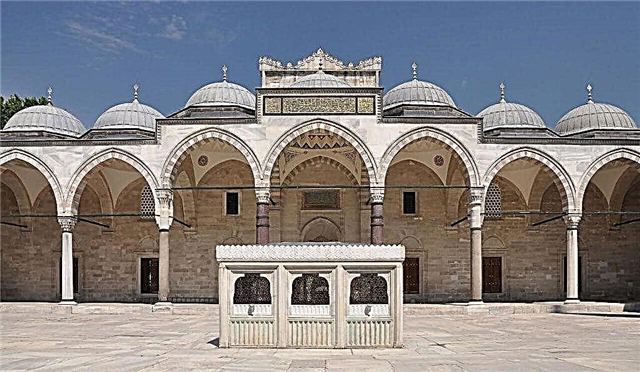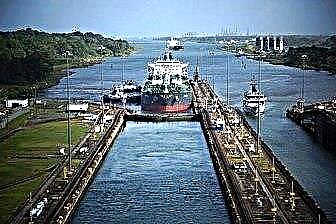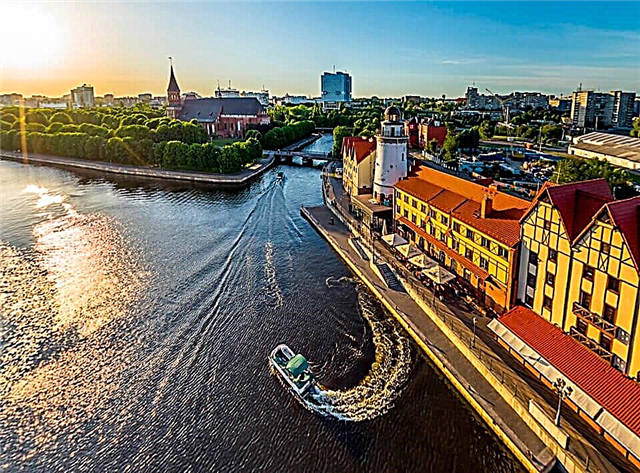Address: Russia, Yaroslavl region, Pereslavl-Zalessky, st. Sovetskaya, 12
Build date: 1740 year
Coordinates: 56 ° 44'07.2 "N 38 ° 51'08.0" E
Content:
In the very heart of Pereslavl-Zalessky, not far from Pushkin Park, there is a beautiful old temple - Vladimirsky Cathedral. It appeared in the Bogoroditsko-Sretensky Novodevichy Convent in the 40s of the 18th century, and almost 160 years later became the New Orthodox Cathedral of the city. This temple is notable for the fact that its large central head is unusually high. And therefore, its appearance is well remembered.
Monastery temple
The Sretensky Novodevichy Convent in Pereslavl was founded in 1659. It was built inside the city's earthen ramparts, in the very center of the ancient city. In another way, this Orthodox monastery was called the Bogoroditsko-Sretensky or Sretensky-Vladimir Novodevichy monastery.

At first, all the buildings in it were wooden. And only in the 30s of the 18th century, the first stone buildings began to be erected here. One of them was the Vladimir collection. His and the adjacent church of Alexander Nevsky were built in the 1740s.
Philip Fadeevich Ugrimov, a wealthy merchant from Pereslavl, became the teacher or, as they say now, the sponsor of the expensive construction. A little later, he founded the largest linen manufactory in the area (1758). At the Ugrimov factory, serfs used machines to make linen of good quality. By 1766, more than 1000 people were employed in the production and 200 looms were in use. This one of the oldest spinning and weaving factories in Russia exists in Pereslavl-Zalessky today. It is called "Zalesye" (formerly "Red Echo") and produces fabrics for rubber products, gas pipelines, as well as filter cloth.
In the 18th century, a high three-tiered bell tower was built in the monastery, next to the cathedral, similar to a round tower with a small dome. They also surrounded the monastery territory with a stone wall. In this fence were the Holy Gates - the main entrance to the territory of the monastery and turrets. It was also planned to build a stone cell building. But the monastery was not rich, and the new construction did not work out.
This women's monastery existed for a little over 100 years, and when the Pereslavl diocese was abolished, it was closed (1764). At this time, the Vladimir Cathedral took on the status of a parish church.

History of the Vladimir Cathedral in the XX century
At the beginning of the 20th century, the spacious building of the cathedral was thoroughly restored and made the main Orthodox church in the city. Local residents began to call it the New Cathedral. The old Transfiguration Cathedral, built at the end of the 16th century, was attributed to it.
In the New Cathedral there were many old liturgical utensils - bowls made of silver - chalices and beautiful tabernacles, as well as well-preserved icons of the 16th-18th centuries. The nearby bell tower was famous for its set of bells with a beautiful deep ringing that echoed beyond the city blocks.
In 1918, the diocese was again recreated in the city. And in the New Cathedral, all hierarchical services began to be held, since it received the status of a cathedral. Archimandrite Damian (Resurrection) was appointed bishop. But this did not last long. The new government carried out the seizure of church values everywhere. Damian was arrested in 1920 and sent to a camp, where he died in the 1940s. Not a better fate awaited the next bishop of Pereslavl, His Grace Leonid (Antoshchenko). He was also arrested and shot in 1937. After his death, the diocese was abolished.
In the 20s of the last century, the Cathedral was still active. It was used as tenants by the local religious society, which consisted of priests and merchants. In 1919, when the five-year lease of the cathedral was concluded, the society numbered 60 people. And at the end of the lease, almost no one was left in it.

In the fall of 1925, Vladimir Cathedral was robbed. Thieves carried out the most valuable silver frames from two icons of the 17th century and the tabernacle of the 18th century. The total weight of the stolen silver items exceeded 4.5 kg. The authorities tried to conduct an investigation, but it led nowhere. Then the time came for an active struggle between the Soviet government and religion, and in 1929 the New Cathedral was closed. To keep the building from being empty, the city library and the Sportsman's House were placed in it. And the cathedral bell tower was used as a fire tower.
In the 30s of the last century, it was decided to connect Pushkin Square with a platform for physical education, laid out in front of the cathedral. According to the authorities, this was "hampered" by the old bell tower of the monastery, which had long been deprived of its ringing bells, and the stone fence located next to the Vladimir Cathedral. The city council of Pereslavl-Zalessky issued a special decree on their demolition. And Glavnauka gave its permission for this. So, in 1933, part of the old stone monastery buildings ceased to exist.
Later, one part of the cathedral was adapted for baking bread. And in the other part, a garage of the Lespromkhoz was arranged, having cut two wells in the floor for car repairs.
The temple was an unenviable sight. Under such conditions of "exploitation" the wall painting faded and partially crumbled, the iconostases disappeared, and garbage was scattered across the territory. In 1936, by the decision of a special commission that examined the churches in the center of Pereslavl-Zalessky, the Vladimir Cathedral was recognized as a historical value and it was decided to preserve it.

Church services in the temple were resumed in 1992. Today only a small fragment of its stone fence and a gatehouse testify to the old monastery. And the foundation of the round bell tower lay under the base of the expanded canvas of the Yaroslavl highway.
The architecture of the Vladimir Cathedral
The cathedral was built of bricks as a summer monastery church. According to the architectural solution, it is a five-headed quadruple with lateral protrusions. All of them are covered with a single roof with lucarnes - window openings in the roof slope. In the refectory, a chapel was made in honor of the Apostle Philip. And the windows of this temple are located in two tiers.
The appearance of the cathedral immediately attracts attention. It has a complex layout and completion typical of the Baroque. The building itself is quite large. And its five chapters on high drums are set close enough to each other. The dome, placed under the main, more massive drum, is disproportionately large in comparison with the other four. And this gives the building a memorable look.
Until recently, the Vladimir Cathedral was white with blue domes. But during the last renovation, it was painted brick-red, and the domes were made green.

Current state and visiting regime
Now Vladimirsky Cathedral is a functioning Orthodox church. It can be accessed from 8.00 to 15.00, and on the days of evening services - from 8.00 to 21.00. The entrance to the cathedral is free. The possibility of amateur photography and video filming must be agreed with the rector.
Services have been held since 1992 in the renovated Filippovsky side-chapel of the church. However, most of the unique cathedral is in need of restoration, and restoration work continues. Funds for it are allocated mainly by parishioners, as voluntary donations. Now work is underway to restore the chapel of the Meeting of the Vladimirskaya Icon of the Mother of God.
Temple feasts are celebrated by parishioners on July 6, September 8, and November 27. In the "white wing" of the cathedral, a permanent exhibition and sale of paintings and photographs by local artists has been created, the exposition of which is regularly updated. On it you can also look at some of the finds made during archaeological excavations.
There is a parking area for tourist buses in front of the cathedral. There is also a pancake shop and a small cafe.There is an impromptu market in front of the cathedral, where they sell souvenirs and products of local craftsmen - the famous Pereslavl embroidery and ceramics.

How to get there
In Pereslavl-Zalessky, Vladimirsky Cathedral is located on Sovetskaya Street, 12, in the city center, inside the old city ramparts. Red Square is located not far from it. If you come to Pereslavl-Zalessky by your own car, then from the federal highway M8, when driving from Moscow, the Vladimir Cathedral will be on the left along the way, and on the right if you go from Yaroslavl.
From the city bus station you can get to the cathedral by regular bus number 1 - to the stop "LIT Plant" or "Sberbank", or use a taxi.











